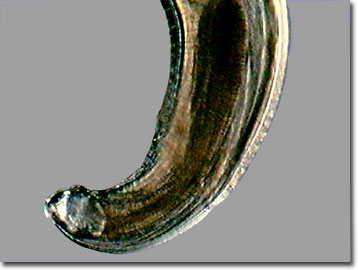Oblique Digital Image Gallery
Canine Nematode (Toxocara canis)
Nematodes comprise a phylum of invertebrates that include free-living and parasitic species, many of which have great economic importance. Known also as the roundworms, some of the parasitic forms are particularly adapted for their hosts and for particular organ systems.

Canine nematodes, often digestive system parasites, plague domestic dogs and other canids (wolves, foxes, coyotes, jackals), as well as other secondary mammalian hosts including humans. There are at least seven different genera of parasitic nematodes of dogs known to veterinary researchers. The most common roundworm responsible for intestinal infestations of dogs is Toxocara canis, referred to as the canine nematode. Canine nematodes, relatively large roundworms, may infest their primary hosts, domestic dogs, in urban settings through soil and feces contaminated with nematode ova, or via intermediate rodent hosts such as mice and rats. When the soils occur in places frequented by children, such as playgrounds, infection of humans becomes a heightened risk.
Male canine nematodes, averaging 10 centimeters in length, are usually shorter than mature females (up to 18 centimeters long). The complex life cycle of T. canis starts off with fertilized eggs passing in the feces of dogs. After 10 to 15 days outside of the host, the roundworms reach an infective larval stage within the eggs. The next unfortunate canine host ingests the eggs inadvertently, and they hatch in the dog's small intestine. The parasitic larva penetrate the gut wall and pass into the lymph and blood circulatory systems, eventually reaching the liver and lungs. In the lungs, the parasites migrate through the alveoli up the bronchioles and into the trachea where they are then swallowed and reach the stomach. After molting, the immature nematode grazes on the intestinal mucous layer where it later matures and starts the life cycle again. Signs of infections in dogs include inflamed livers and lungs, dry coughs, and distended abdomens. Treatment often involves worming formulations, which are usually chlorinated hydrocarbon pesticides. Infected human children often display abnormal behavior, including eating dirt (geophagy), flu-like symptoms, and visualization of swimming larva in the eyes.
Contributing Authors
Cynthia D. Kelly, Thomas J. Fellers and Michael W. Davidson - National High Magnetic Field Laboratory, 1800 East Paul Dirac Dr., The Florida State University, Tallahassee, Florida, 32310.
BACK TO THE OBLIQUE IMAGE GALLERY
BACK TO THE DIGITAL IMAGE GALLERIES
Questions or comments? Send us an email.
© 1995-2025 by Michael W. Davidson and The Florida State University. All Rights Reserved. No images, graphics, software, scripts, or applets may be reproduced or used in any manner without permission from the copyright holders. Use of this website means you agree to all of the Legal Terms and Conditions set forth by the owners.
This website is maintained by our
Graphics & Web Programming Team
in collaboration with Optical Microscopy at the
National High Magnetic Field Laboratory.
Last Modification Friday, Nov 13, 2015 at 01:19 PM
Access Count Since September 17, 2002: 17864
Visit the website of our partner in introductory microscopy education:
|
|
